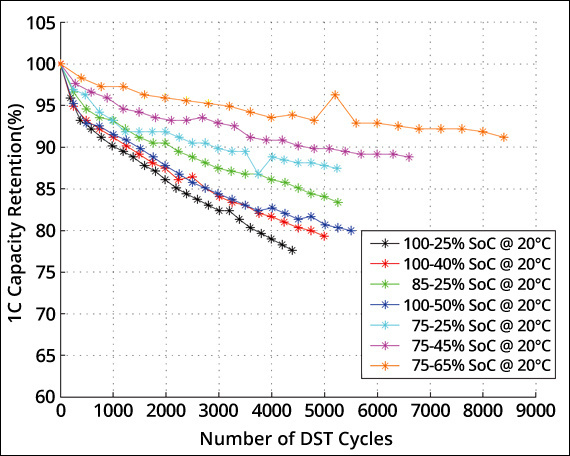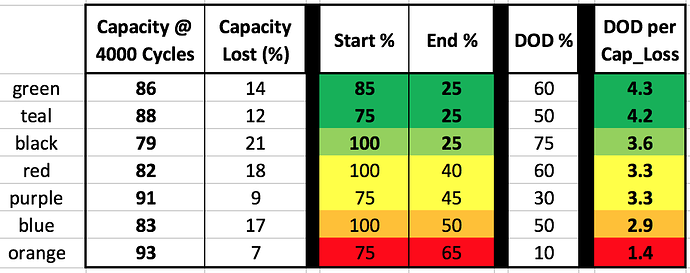This has been a good discussion but it’s also getting late here and I have to get up early so good night.
In that case, I’m going to test a cutoff start voltage of 28v and cutoff end at 26v, let’s see how range is improved
This an interesting chart. You’ll notice that 75-65% gives the best cycle length. But this is somewhat misleading because you are only using 10% of the battery’s capacity.
So we don’t necessary seek a long cycle life, but rather- a long cycle range [miles].
We want to maximize range (i.e. Depth of Discharge) while minimizing capacity loss.
There are multiple values at play here:

I wanted to see if we could use this chart to find an optimal charging/discharging strategy. I interpolated values at 4000 cycles to find the percent capacity loss, and recorded them in the table below. Assume that DOD is proportional to the amount of energy used, and therefore proportional to your cycle range.
We want a high range (DOD%) with minimal Capacity Loss:
This would suggest that the best strategy is to charge to 85% and discharge to 25%.
-
(85-25%) maximizes range with the least effect on battery life
-
(75-25%) is much better than (100-50%) but has the same theoretical range (50% DOD)
-
(100-25%) has the best range, and would still be a viable charging strategy. It is not nearly as bad as the first chart would suggest because you are getting much higher range for each discharge cycle
What was the charging strategy used? Did they charge at 4.2 volts and just stop at 85% or did they charge with reduced voltage?
I feel like you guys are overcomplicating this. Charging to 4.1V per cell instead of 4.2 only decreases the usable energy by ~3%. This is barely noticeable and will already double the cycle life which is good. The level of discharge is much harder to control as that depends on your riding style and the distance you travelled. I am pretty sure you will not stop riding while in the woods far away from home just because you reached 25% of your capacity. You will ride until you get to the next convenient power outlet. The only value that makes sense to adjust is the end of charge voltage. After that just ride your battery and charge it as often as possible.
You’re missing the point. You can’t always charge to 4.10V if your BMS does not start balancing until 4.15V.
Charging to 4.20V is fine but not ideal for battery longevity
Which is why I don’t use a BMS in the first place  Also I am pretty sure those discharges were not at the same currents we use - which will decrease cylce life even more. Your numbers are already “cleaned” of those additional factors and gives the result for only the charge voltage deviations.
Also I am pretty sure those discharges were not at the same currents we use - which will decrease cylce life even more. Your numbers are already “cleaned” of those additional factors and gives the result for only the charge voltage deviations.
I’ll bet the regenerative braking doesn’t help either.
4.1 Volts seems like a good deal for longevity, because it has such a minimal impact on SoC (assuming that you can balance your pack). I do believe pretty much all manufacturers spec their cells at the 4.2 charge voltage and then give out the cycles for 70% capacity left with full DoD.
Samsung INR18650-25R
LG INR18650-HG2
So we are already trying to outperform the spec’d cycle performance, but that doesn’t mean we shouldn’t do it.
Those are not “my numbers”, and they are not “cleaned” of anything. I am simply interpreting and analyzing the data in the article. The article you presented
Salty much?
You used them to make your case - I just doubted that you can take them quantitatively like that.
Actually I used the numbers to disprove my original theory…
I’m not saying that your battery will have exactly 86% capacity if your discharge it from 85-25% exactly 4000 times. Not at all. Your actual cycle count will be much less because of our high discharge rates. It’s not even something you can predict because of all the variables involved. The point is hold one variable constant (the discharge rate) to find general trends to help guide our charging/discharging.
The numbers suggest it is better to do a partial charge + full discharge (i.e., 85-25%), than it is to do a full charge + partial discharge (i.e., 100-40%).
Or as @PXSS put it more simply:
But charging to 100% is often necessary, especially if you use a BMS for balancing. If you were really concerned about battery longevity, maybe you’d only want to go to 4.20V every few cycles. Personally I don’t think it really matters; I have way more range than I need, so even 70% capacity after hundreds of cycles is perfectly fine for my needs
So what method do you use to balance your pack?
None - I just leave them at 41v until the current drops significantlly to like 100-200mA.
That is the @whitepony way  and it worked perfectly so far.
and it worked perfectly so far.
I use a DROK charger - that is basically a small lab power supply Made myself a 3D printed case for it together with a laptop psu to get the necessary DC voltage for the DROK
The issue with this data is that they do not explore charging to 65% and discharging to 15% or 55% to 5%.
How do we know that 75%-25% is ideal or 85%-25%.
I’m with @Maxid, charge lower and ride till it dies. Low voltage doesn’t hurt cells as long as you’re not storing them there long enough so that self discharge kills them. The only reason not to discharge to 0% is because if the cells are not balanced at the low end, you could end up with a cell below the 2.5V limit. So in my case I will be lowering my cutoff to 26V. What I need now is a proper watt controller instead of current controller. I may talk to @Ackmaniac to see if he’s willing to take up the task, e.g. 0 throttle corresponds to 0W and 100 Throttle corresponds to a defined Wattage.
@Namasaki I’m sure we could source a BMS from Bestech designed to balance charge at a lower voltage. You can also balance your packs with an RC charger which is what I do
Also, we do not need to balance on every charge. I would say once every 10 cycles or once a week, given that we use good cells.
BTW I think I figured out why people keep having issues charging to 100% with a BMS. In short, the BMS only balances with very small currents and the brick charger shutoff current is higher than this, therefore it will turn off before it starts balancing. @Namasaki’s lab supply works because it’s current cutoff is lower than the max balance current.
@Maxid, if you do not balance at all how do you know if one of your cells is going bad? Basically, you’re just using a brick charger straight to the battery. If one cell does go bad and you don’t catch it, you could easily kill the rest of your pack, even if you’re only charging to 41V
Im running batteries like that since 3 years now - some of them under quite a lot of use with several thousand kilometers of boarding per year. initially I was suspicious and kept measuring cell voltages quite often, but I got more sloppy by each month. my latest boards dont even have balance wires anymore, because the 2 batteries I kept monitoring never ever showed any drift at all. like at ALL!
several factors contribute to that i think:
- using only quality cells from long standing quality distributors such as nkon.nl
- 4.1V/cell cut off for better cell life and some robustness towards drifting (if it should ever occur)
- winter storing the battery in a cool place at 3.6V/cell
- I never discharge lower than 3.0V/cell, vesc soft cutoff 3.4V->3.0V
- i never draw a lot of current when the battery is cold - when I ride in winter, I start with a room temperature battery
- i generally dont really demand much current from my batteries, cause Im mostly single motor carving
- I avoid all heat, always keep the board in shadows during summer
My 10S battery is divided into two 5S packs with balancing wires. This means I can check them on a standard RC charger. The few times I tried all cells were perfectly in sync.
Not saying it’s not doable, but you have to be very vigilant on how you treat your cells and all as @whitepony is. Using quality cells is a big one, but every once in a while you just get unlucky and get a dud.
I personally rather not limit their performance that heavily and balance them whenever I see them go more than 50mV out of balance but I also own a $350 charger that has programmable charge and discharge features


